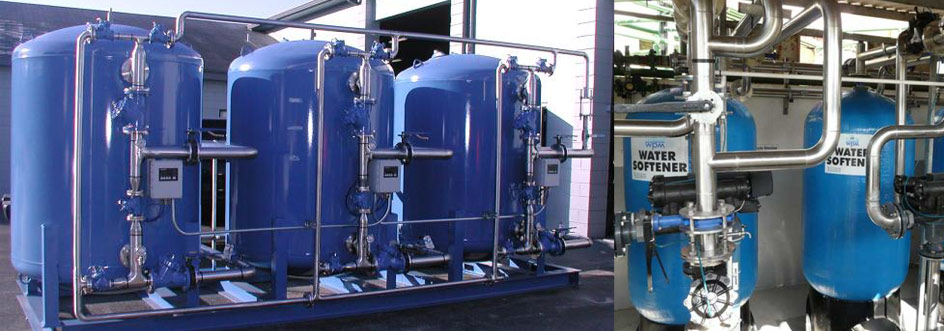water softening plant
A hard water softener is an appliance that uses sodium chloride, also known as salt, to treat hard water. Hard water contains an excess of minerals such as calcium, magnesium, manganese, and iron that can be an expensive nuisance for a home. These minerals are taken up in the underground water supply and, as the water is heated in the home, they crystallize and stick to household surfaces. Sodium chloride, the effective component of water softener, works to replace these unwanted minerals.
A water softener is a fairly simple appliance that is stocked with salt. In water softening process the water supply passes through the water softener over resin beds, rows of resin beads perform an ion-exchange. The resin beads chemically attract the unwanted ‘hard’ mineral ions and exchange them with sodium ions. Softener resin is mainly strong acid Cation resin.
When the resin beds become saturated with the minerals, the water softener flushes them out with a salt solution called brine and the process begins again. Water softeners are fairly easy to operate and maintain. All that needs to be done after installation is to periodically add sodium chloride and the water softener does the rest.
Sodium salts are not hard scales forming so that water without the calcium and magnesium salts is called soft water.
Water softening is an important process, because the hardness of water in households and companies is reduced during this process. When water is hard, it can clog pipes and soap will dissolve in it less easily. Water softening can prevent these negative effects. Hard water causes a higher risk of lime scale deposits in household water systems. Due to this lime scale build-up, pipes are blocked and the efficiency of hot boilers and tanks is reduced. This increases the cost of domestic water heating by about fifteen to twenty percent. Another negative effect of lime scale is that it has damaging effects on household machinery, such as laundry machines. Water softening means expanding the life span of household machine, such as laundry machines. Water softening means expanding the life span of household machine, such as laundry machines, and the life span of pipelines. It also contributes to the improved working, and longer lifespan of solar heating systems, air conditioning units and many other water-based applications.Water softening methods normally are one of the followings.
- Soda lime treatment
- Ion exchange resin based
- Nano filtration
- Reverse Osmosis
Water softeners are specific ion exchangers that are designed to remove ions, which are positively charged. Softeners mainly remove calcium (Ca2+) and magnesium (Mg2+) ions. Calcium and magnesium are often referred to as ‘hardness minerals’. Softeners are sometimes even applied to remove iron. The softening devices are able to remove up to five milligrams per litre (5 mg/L) of dissolved iron. Softeners can operate automatic, semi-automatic, or manual. Each type is rated on the amount of hardness it can remove before regeneration is necessary. A water softener collects hardness minerals within its conditioning tank and from time to time flushes them away to drain. Ion exchangers are often used for water softening. When an ion exchange is applied for water softening, it will replace the calcium and magnesium ions in the water with other ions, for instance sodium or potassium. The exchanger ions are added to the ion exchanger reservoir as sodium and potassium salts (NaCl and KCl).

